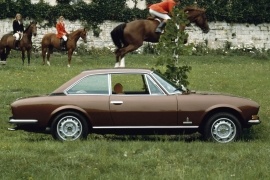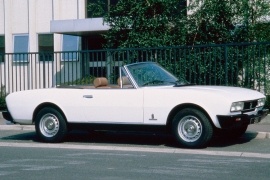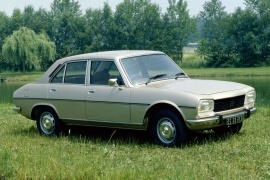PEUGEOT 504 Models/Series Timeline, Specifications & Photos
First production year: 1968
Engines: Gasoline, Diesel
Peugeot introduced an upgraded version of the 504 lineup in 1974, and besides the sedan, the convertible and the coupe were also refreshed.
Back in the early '70s, Peugeot was competing against the growing German auto industry and produced the 504 Coupe as a personal luxury coupe. As a result, it could offer everything that other premium carmakers did. Still, the French automaker understood that it had to adapt. As a result, it provided a more powerful version and included some visual changes to the car to keep its look fresh on the market.
Working together with the Italian coach manufacturer Pininfarina was a very good idea. Thus, even though it shared its underpinnings with the 504 sedan, it looked very different. Its long hood and the cab-rearward design were on par with the German coupes from Mercedes-Benz and BMW, just better. For the 1974 model, the refreshed version featured a new front fascia with rectangular, horizontal headlights. The slim chromed bumper was adorned with a rubber strip that crossed it from one end to the other. From its profile, the '74 model year revealed its chromed, flush door handles. Finally, at the back, the carmaker added a different set of taillights with a rectangular design instead of the three tilted lamps fitted on its predecessor.
The interior also went through some changes. Peugeot added adjustable headrests to the front bucket seats and also included vinyl upholstery for selected trim levels. Its three-dial instrument cluster remained basically the same as before. An electronic clock was added to the dashboard, replacing the previous analog one.
One of the most significant improvements for the 1974 model year was the addition of the 2.7-liter PRV engine. This was offered on selected markets and was paired with a five-speed manual.
In 1973, Peugeot introduced a facelifted version for the entire 504 lineup, including the open-top version, although it reached its customers as a 1974 model.
The French automaker was already working on the facelifted version when the Oil Crisis started in 1973. Moreover, adding better, fuel-efficient engines was nothing but good news for customers. In addition, the car's exterior was updated. Nevertheless, it was already a great-looking vehicle loved by its owners.
Derived from the 504 Coupe version, which was penned by Pininfarina, the Cabriolet version featured a low stance and an elegant profile. With the updated version, the front of the vehicle received a plastic grille for the radiator while the quad-headlights system was kept, although with some slight aesthetic modifications. The four headlamps had the same size, with a rectangular shape and rounded corners. The turn signals were still mounted lower inside the newly designed plastic bumper.
Inside, the car was an absolute feat for its customers, offering a true four-seat experience. At the front, the bucket seats with adjustable headrests featured side bolstering. They were separated by a tall center console extended into the center stack. The dashboard featured three individual clusters for the dials. Also, the car featured power front windows. Unfortunately, there were no side windows for the rear passengers.
Under the hood, Peugeot installed a new, fuel-injected engine that offered the same 106 PS (103 hp) power but lowered the fuel consumption.
The 504 appeared on the market in late 1968 and it was crowned as the 1969 Car of The Year in Europe for its overall package.
Back in the late '60s, Europe was not on the verge of power and speed, such as the Americans, which were in the middle of the muscle-car era. The customers asked for sedans with adequate interior room for five and fuel-efficient engines. As for the performance, there were just a few carmakers to offer that, but Peugeot was not one of them. It replaced the 404 range as its flagship model. By European standards, the 504 was a large family sedan, even though it was just 4.48 m (176.6") long.
Peugeot relied on Pininfarina studios to design the car, and the result was a unique shape for those times, with a raked-forward rear window and a sloped-down trunk lid. At the front, its headlights featured a taller outer side. The flat grille sported two horizontal slats that supported the company's badge: a lion. As an improvement on the safety side, Peugeot installed rubber blocks on the chromed metallic bumpers.
Inside, the carmaker installed a flat dashboard with a taller instrument cluster with three round dials. Its front bucket seats featured adjustable headrests, which was also something new for those times. In the back, the large bench was good for two since the transmission tunnel was tall and left room enough only for a child.
Under the hood, Peugeot introduced a range of gasoline and diesel engines ranged between 66 hp and 138 hp. A four-speed manual was fitted as standard for the entire range, while a three-speed automatic was on the options list for selected engine versions.


